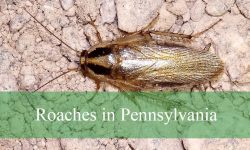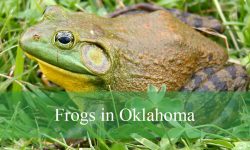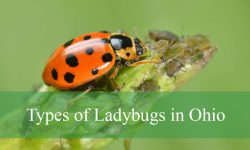Among Vermont’s forests, lakes, and meadows lives a wide variety of wildlife, including a few insects that can cause real trouble. Most bugs are harmless and even helpful, but some can bite, sting, or spread diseases when disturbed. Knowing which ones to watch out for can make a big difference during outdoor adventures.
From ticks that carry Lyme disease to hornets with painful stings, Vermont is home to several small but dangerous creatures. They’re most active during the warm, humid months and often appear around gardens, trails, and ponds.
Learning to recognize these insects and understanding how to avoid them helps keep you safe while enjoying nature. This guide introduces 21 of Vermont’s most dangerous bugs, complete with pictures, identification details, and useful safety tips.
Types of Dangerous Bugs Found in Vermont
Deer Tick (Black-legged Tick)
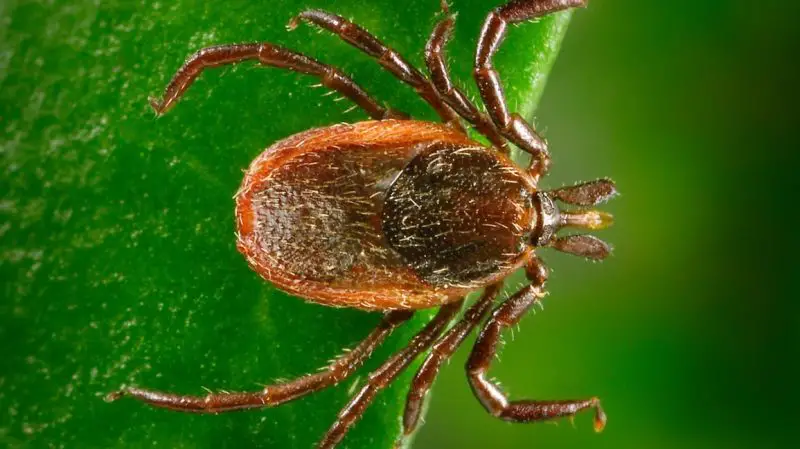
The Deer Tick, also known as the Black-legged Tick (Ixodes scapularis), is a small arachnid that measures about 3–5 millimeters in length, with a reddish-brown body and a distinctive dark, shield-like plate behind its head. The females are slightly larger and rounder, particularly after feeding, when their bodies become engorged and grayish-blue. These ticks are often mistaken for poppy seeds due to their tiny size in the nymph stage, which makes them easy to overlook on human skin or animal fur.
Deer Ticks are known for their parasitic lifestyle, feeding on the blood of mammals, birds, and reptiles. They are most active during spring and fall, attaching themselves to hosts by climbing onto grass blades or shrubs and waiting for contact. Once attached, they feed slowly for several days before dropping off to continue their life cycle. Despite their small size, their bite can have significant consequences, as they are primary vectors for serious diseases.
These ticks carry pathogens that can transmit Lyme disease, anaplasmosis, and babesiosis to humans and pets. Lyme disease, caused by Borrelia burgdorferi, is the most common tick-borne illness in Vermont, producing symptoms such as fever, fatigue, and the characteristic bull’s-eye rash. Because of their ability to spread multiple infections, Deer Ticks are considered one of the most dangerous arthropods in the northeastern United States.
In Vermont, Deer Ticks thrive in humid, forested environments with dense vegetation and abundant wildlife. They are particularly common in wooded areas frequented by deer and small mammals, which serve as their primary hosts. Tick activity peaks during warm months but can persist whenever temperatures remain above freezing. Preventing bites through repellents, protective clothing, and thorough tick checks after outdoor activities is crucial in minimizing the risk of disease transmission.
Dog Tick (American Dog Tick)
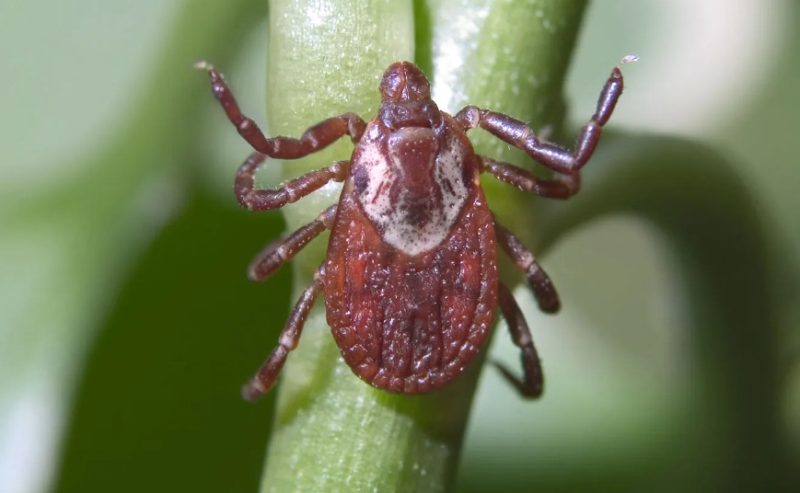
The Dog Tick (Dermacentor variabilis), also known as the American Dog Tick, is larger than the Deer Tick, measuring up to 15 millimeters when fully engorged. It has a brown, oval body with distinctive white or gray markings on its back, particularly on the scutum (shield). Unlike the smaller black-legged tick, its mouthparts are shorter and broader, making it easier to identify. Females tend to enlarge significantly after feeding, while males remain relatively flat.
This tick species feeds primarily on medium to large mammals, such as dogs, raccoons, and humans. Adults are often found crawling in grassy fields or along trails, waiting to attach to a passing host. Dog Ticks are most active during the warmer months, typically from April through September in Vermont. Their bites are painless but can cause irritation, and their tendency to attach for extended periods increases the risk of disease transmission.
Dog Ticks are notorious vectors of Rocky Mountain spotted fever and tularemia. The former, caused by Rickettsia rickettsii, is a potentially life-threatening bacterial infection characterized by fever, rash, and muscle pain. Although cases in Vermont are rare, the presence of these ticks keeps the risk active. Additionally, they can cause tick paralysis in pets and humans through a neurotoxin released during prolonged feeding.
In Vermont, Dog Ticks prefer open, sunny habitats such as meadows, fields, and forest edges, often near areas frequented by wildlife and domestic animals. They are less tolerant of heavily wooded or extremely humid environments compared to Deer Ticks. Regular tick checks after outdoor activity, especially on dogs and clothing, are essential in areas with high tick density to prevent bites and potential infections.
Mosquito (Various species)
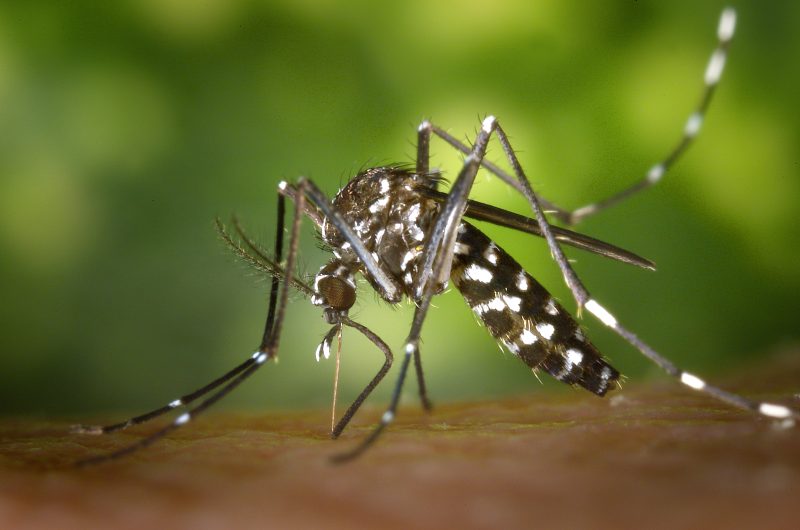
Mosquitoes are among the most familiar and widespread biting insects in Vermont, belonging to the family Culicidae. Adult mosquitoes typically measure between 3 to 6 millimeters in length, with slender bodies, long legs, and a prominent proboscis used for piercing skin and feeding on blood. Only females bite, as they require protein for egg development, while males feed on nectar. Their buzzing sound and quick movements make them easily recognizable and often a nuisance during summer.
Mosquito behavior varies by species, but most are crepuscular or nocturnal, being most active during dawn and dusk. They breed in standing water, including ponds, birdbaths, and even puddles, where their larvae (known as wrigglers) develop. Adult mosquitoes are capable of flying long distances in search of hosts, using carbon dioxide, body heat, and scent to locate their targets. Their bites cause itching and swelling due to allergic reactions to their saliva.
These insects are far more than just annoying—they are potential carriers of several serious diseases. In Vermont, mosquitoes can transmit West Nile virus and Eastern equine encephalitis (EEE), both of which can lead to severe neurological conditions in humans and animals. While infections remain uncommon, outbreaks occur periodically, particularly after wet summers when mosquito populations surge.
Mosquitoes are found throughout Vermont, thriving in wetlands, forests, and urban areas with stagnant water sources. Their activity peaks between late spring and early fall, coinciding with warm, humid conditions. Controlling breeding sites by eliminating standing water, using insect repellents, and installing screens or nets are effective ways to reduce bites and disease risk in affected areas.
Yellowjacket Wasp
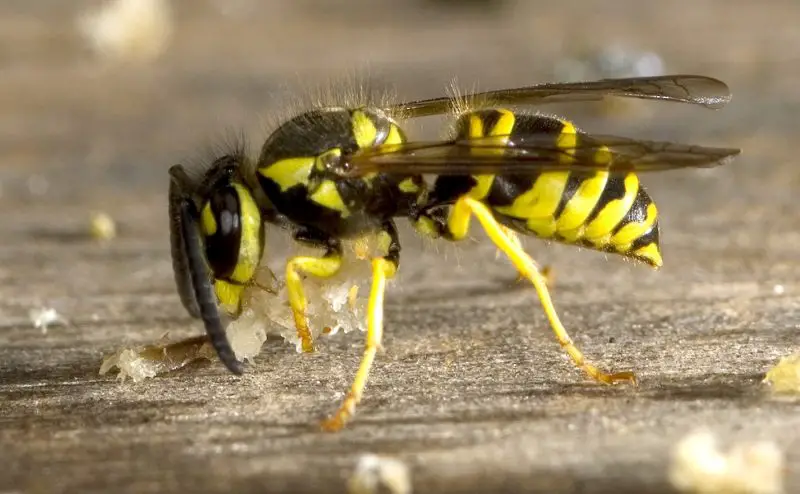
Yellowjackets are aggressive, black-and-yellow wasps belonging to the genus Vespula. They are medium-sized insects, measuring about 10–16 millimeters in length, with bold coloration and a narrow “waist” between the thorax and abdomen. Unlike bees, their smooth stingers allow them to sting repeatedly, injecting venom with each attack. They are commonly mistaken for honeybees but can be identified by their rapid, darting flight patterns and shiny bodies without noticeable hair.
These wasps are highly social, living in colonies that can contain thousands of individuals. Their paper-like nests are often hidden underground, in wall cavities, or under eaves, making them difficult to detect until disturbed. Yellowjackets are omnivorous scavengers, feeding on sugary substances and proteins such as insects and human food scraps. They become particularly aggressive in late summer and fall as natural food sources dwindle.
The sting of a Yellowjacket is painful and can cause severe allergic reactions in sensitive individuals, including swelling, dizziness, or even life-threatening anaphylaxis. Their venom contains potent toxins that trigger intense burning and inflammation. Unlike some wasps, they tend to attack in groups when their nest is threatened, increasing the danger of multiple stings. Even non-allergic individuals may experience prolonged pain and redness after being stung.
In Vermont, Yellowjackets are widespread in gardens, parks, forests, and residential areas. They are most active during warm months, especially around late summer picnics or outdoor gatherings where food is available. Avoiding sudden movements near wasps, sealing garbage containers, and calling pest control professionals to remove nests safely are essential preventive measures against these aggressive insects.
Paper Wasp
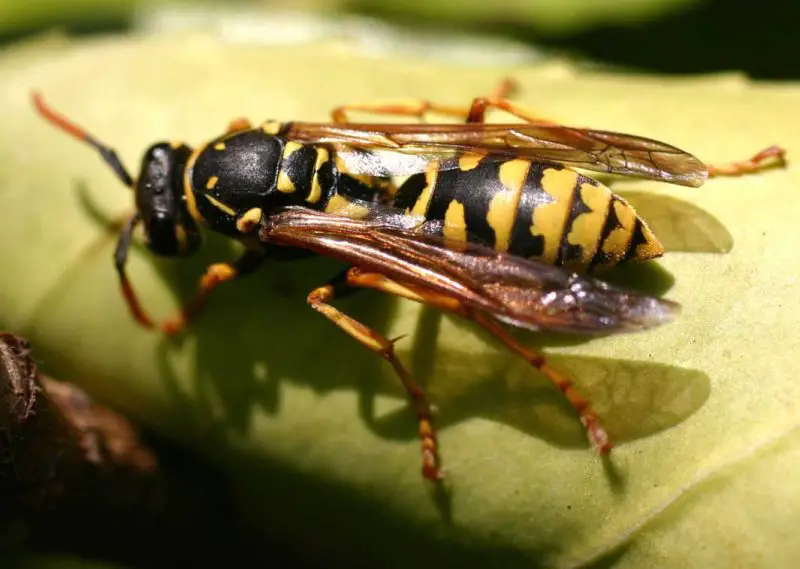
The Paper Wasp (Polistes spp.) is another stinging insect found throughout Vermont, recognized by its slender body, long legs, and reddish-brown or yellow-and-black coloration. Measuring around 16–20 millimeters in length, it has a more elongated appearance than the compact Yellowjacket. Its name comes from the papery nests it constructs using chewed plant fibers mixed with saliva, forming umbrella-shaped combs that hang from eaves, branches, or beams.
Paper Wasps are generally less aggressive than Yellowjackets but will defend their nests fiercely when threatened. They are beneficial predators, feeding on caterpillars, flies, and other garden pests, which they paralyze and carry back to feed their larvae. Adults also consume nectar and fruit juices. Despite their ecological role, their proximity to human dwellings often results in conflict, especially during the breeding season.
The sting of a Paper Wasp is sharp and painful, delivering venom that causes burning, redness, and swelling. Multiple stings can be dangerous, especially for those with allergies, and may lead to anaphylactic shock in severe cases. While they rarely attack unprovoked, disturbing a nest can trigger an immediate defensive swarm. Their repeated stings can cause local tissue damage or intense discomfort lasting several hours.
In Vermont, Paper Wasps are common in suburban and rural environments, building nests on porches, barns, sheds, and trees. They are most active during summer, with colonies dying off in late fall as the queen seeks shelter for winter. Regular inspection of outdoor structures and careful removal of early nests in spring can prevent colonies from expanding and becoming hazardous later in the season.
Bald-faced Hornet
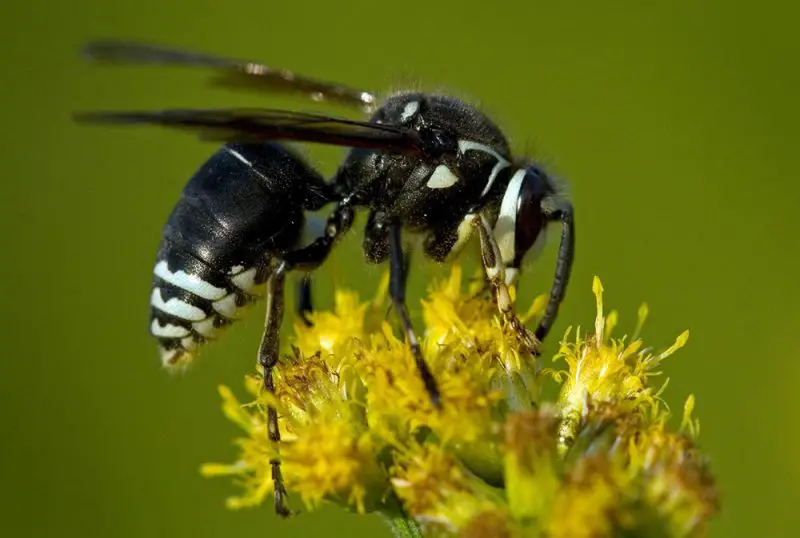
The Bald-faced Hornet (Dolichovespula maculata) is a large and striking black-and-white wasp known for its aggressive defense of its nest. Adults typically measure between 15 to 20 millimeters in length, with white facial markings, black bodies, and translucent wings. Despite its common name, it is not a true hornet but rather a type of aerial yellowjacket. Its distinct coloration and robust build make it easily recognizable when hovering near shrubs, trees, or buildings.
These hornets live in colonies containing hundreds of individuals, constructing large paper nests that can grow to the size of a basketball. The nests, made from chewed wood fibers, are usually found high in trees, shrubs, or under roof eaves. Bald-faced Hornets are omnivorous, feeding on nectar and other insects such as flies and caterpillars. They play an important ecological role in controlling pest populations, though their aggression makes them a frequent concern for humans.
The Bald-faced Hornet is highly defensive and can sting multiple times, injecting a strong venom that causes intense pain, swelling, and redness. Unlike honey bees, their smooth stingers do not detach after use, allowing repeated stings. When their nest is disturbed, the colony may swarm and attack in unison, posing a significant threat to both humans and pets. Their venom can also trigger severe allergic reactions, including anaphylaxis in susceptible individuals.
In Vermont, Bald-faced Hornets are common during summer and early fall, particularly in wooded and suburban areas. Their nests are often spotted in trees, along forest edges, or near homes. The insects become increasingly aggressive as the season progresses and food sources diminish. People should avoid approaching nests and seek professional removal if one is found near human activity areas to prevent dangerous encounters.
Honey Bee
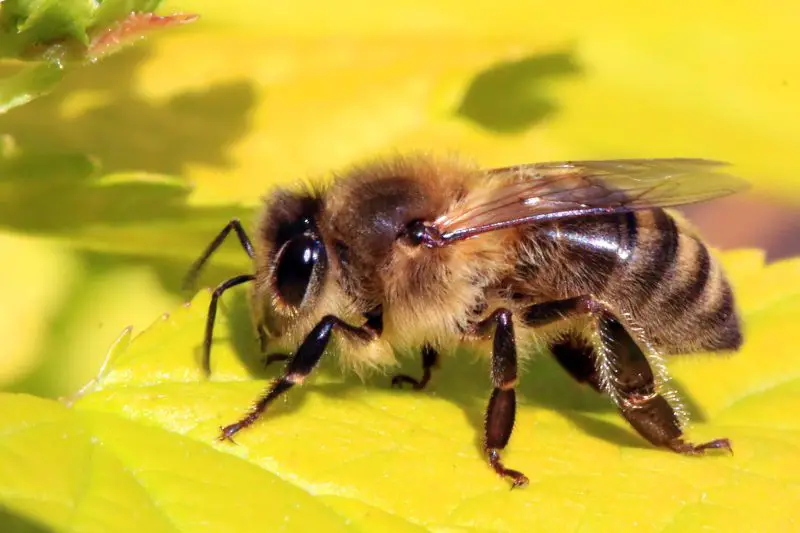
The Honey Bee (Apis mellifera) is one of the most familiar and beneficial insects in Vermont, easily identified by its golden-brown body with black bands, fuzzy thorax, and translucent wings. Adults measure about 12 to 15 millimeters long and are known for their social behavior and intricate hive structures. Each colony consists of thousands of worker bees, drones, and a single queen responsible for egg-laying.
Honey Bees are vital pollinators that support both wild ecosystems and agriculture by transferring pollen between flowers. They feed on nectar and pollen, which they convert into honey and wax inside the hive. Their hives are typically found in hollow trees or human-made beekeeping boxes. While usually non-aggressive when foraging, they can become defensive near their nests or when provoked, particularly in hot or humid weather.
A Honey Bee can sting only once because its barbed stinger becomes lodged in the skin, tearing away from its body and causing the bee’s death. The sting delivers venom containing melittin, a compound that produces pain, swelling, and inflammation. Most stings result in mild reactions, but for people with bee venom allergies, even a single sting can trigger severe anaphylaxis—a life-threatening condition requiring immediate medical attention.
In Vermont, Honey Bees thrive across rural fields, gardens, and orchards during spring and summer. They play a crucial role in pollinating crops such as apples, blueberries, and clover. Beekeeping is a common practice throughout the state, and wild colonies often inhabit forested regions. Despite their importance, Honey Bees face threats from pesticides, habitat loss, and parasites like the Varroa mite, making their conservation vital for local biodiversity.
Carpenter Bee
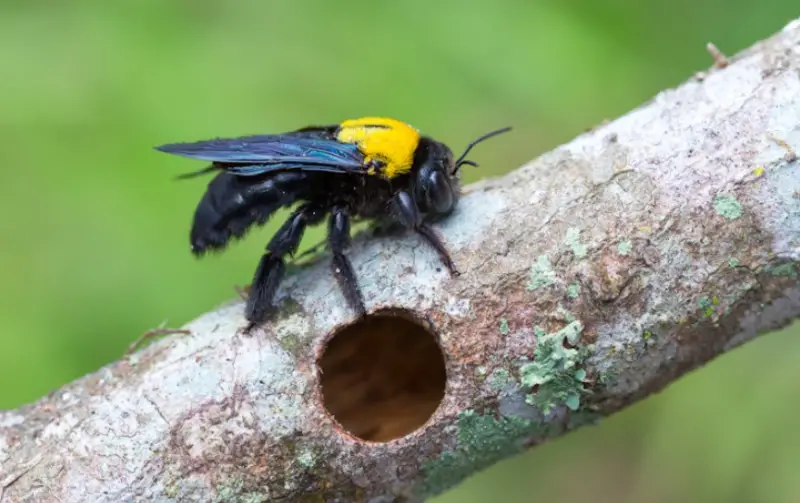
The Carpenter Bee (Xylocopa virginica) is a large, solitary bee commonly found across Vermont, especially near wooden structures. It is often mistaken for a bumblebee but can be distinguished by its shiny, hairless black abdomen. Adults measure between 20 and 25 millimeters in length, with males featuring a small white spot on their faces. Their flight is loud and deliberate, often seen hovering around decks, fences, or eaves.
Unlike social honey bees, Carpenter Bees live alone. Females excavate tunnels in untreated wood to create brood chambers for their offspring, using their strong mandibles to bore holes that are perfectly round and about the size of a dime. These tunnels can weaken wooden structures over time if infestations are left unchecked. Despite their nesting habits, Carpenter Bees are also effective pollinators for various plants and flowers.
Only female Carpenter Bees can sting, and they typically do so only when handled or provoked. Males, which are more territorial and often hover aggressively near people, lack stingers entirely. The sting, while painful, is rarely dangerous unless an allergic reaction occurs. The primary concern with Carpenter Bees is the structural damage they cause, as repeated tunneling can compromise beams, decks, and siding.
In Vermont, Carpenter Bees are active during late spring through summer, particularly in areas with abundant timber and flowering plants. They prefer sunny locations and untreated wood, such as barn siding, outdoor furniture, or fence posts. Applying paint or sealant to wood surfaces can deter nesting. Though often feared, Carpenter Bees are generally harmless and valuable to gardens due to their pollination role.
Fire Ant (invasive species)
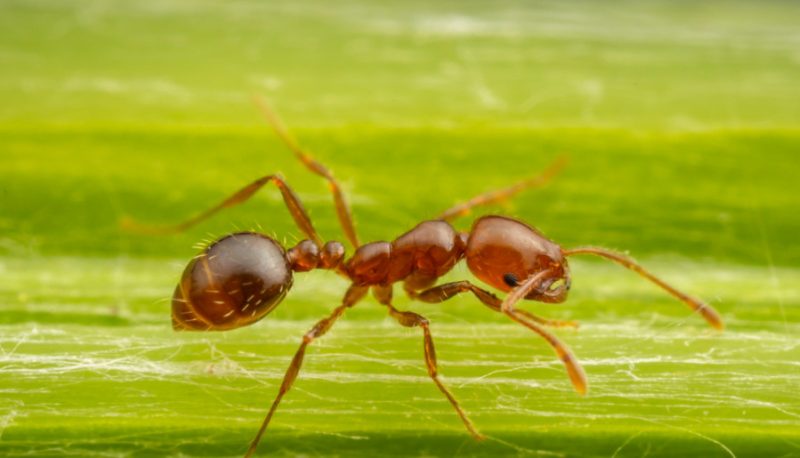
Fire Ants (Solenopsis invicta) are invasive insects that have recently expanded northward and can occasionally be encountered in parts of southern Vermont. They are small, reddish-brown ants measuring about 2 to 6 millimeters long, with aggressive behavior and a potent sting. Colonies are large, containing hundreds of thousands of individuals, and their nests form distinctive dome-shaped mounds in soil or grassy areas.
These ants are highly territorial and will swarm rapidly when their mound is disturbed. Fire Ants are omnivorous, feeding on insects, seeds, and animal matter. They thrive in warm, open habitats such as lawns, gardens, and farmlands. Their organized defense behavior and resilience make them difficult to control once established. In Vermont, sightings are rare but concerning, as warming climates may aid their future spread.
Fire Ant stings are extremely painful, causing an immediate burning sensation followed by itchy, white pustules that can become infected if scratched. Multiple stings from a swarm can result in severe discomfort, and in sensitive individuals, the venom can trigger dangerous allergic reactions or anaphylaxis. Their aggressive swarming behavior makes them particularly hazardous for children, pets, and wildlife.
While still uncommon in Vermont, Fire Ants pose an increasing threat due to their invasive nature. They are typically found in imported materials like nursery plants or soil products. Avoiding contact with their nests and using professional pest control for confirmed infestations is recommended. Vigilant monitoring is essential to prevent their establishment in the state’s ecosystems.
Horsefly
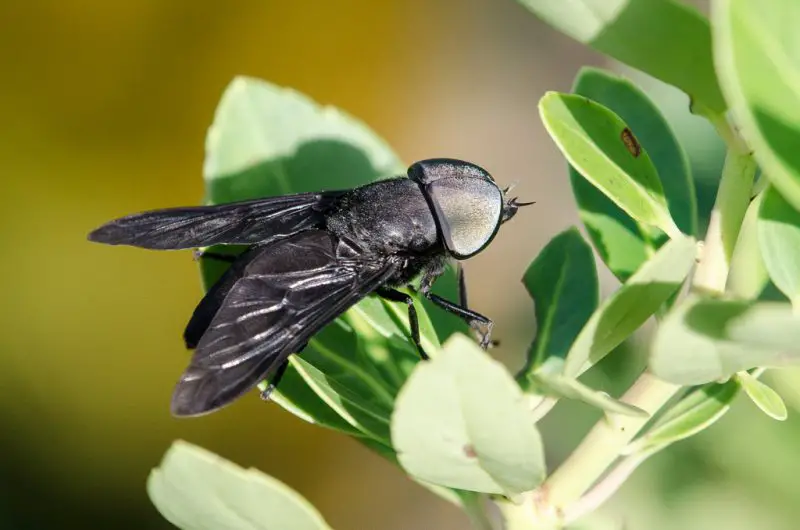
Horseflies (family Tabanidae) are large, fast-flying insects known for their painful bites and persistent behavior. Adults range from 10 to 25 millimeters in length, with gray or brown bodies, large iridescent eyes, and broad wings. Female horseflies possess scissor-like mouthparts designed to cut through skin and feed on blood, while males feed exclusively on nectar and plant juices. Their size and loud buzzing make them hard to ignore during outdoor activities.
Horseflies are most active during warm, sunny days, especially near bodies of water where they lay their eggs. Their larvae develop in moist soil or muddy areas, feeding on small invertebrates before maturing into adults. Female horseflies rely on blood meals for reproduction and can detect movement, carbon dioxide, and body heat from a considerable distance. Their bites are notorious for causing immediate pain and bleeding.
The bite of a horsefly results in sharp pain, swelling, and irritation. Because their mouthparts tear the skin rather than pierce it, the wound can bleed freely and take time to heal. While they do not inject venom, horseflies can transmit bacteria and parasites between animals, occasionally leading to infections or diseases such as tularemia or anthrax in livestock. Repeated bites can also cause allergic reactions in some people.
In Vermont, horseflies are common during midsummer, particularly in wetlands, pastures, and forested lakeshores. Their presence is most noticeable around livestock and humans engaged in outdoor recreation. Wearing light-colored clothing, applying insect repellent, and avoiding heavily infested areas during peak hours can help reduce the likelihood of bites. Though primarily a nuisance, their painful attacks make them one of Vermont’s most bothersome summer pests.
Deer Fly
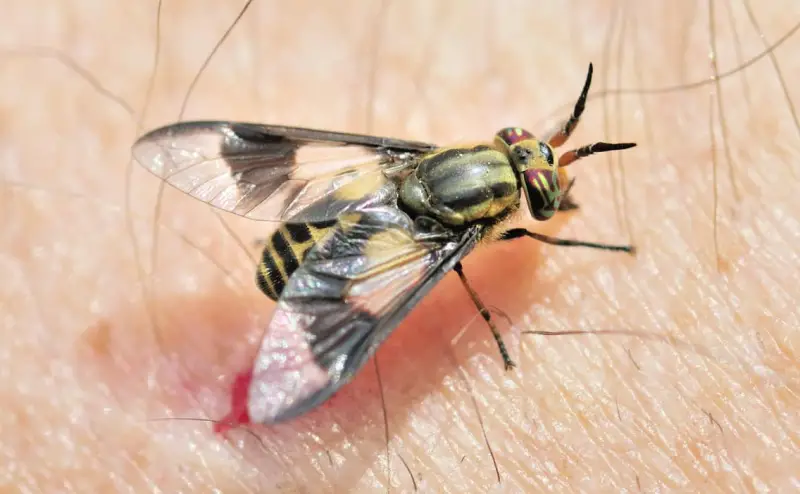
The Deer Fly (Chrysops spp.) is a small, aggressive biting insect found throughout Vermont, especially in wooded and wetland areas during the warmer months. Adults are typically 6 to 10 millimeters long, with yellow or brown bodies, patterned wings, and strikingly colorful, iridescent eyes. These flies are related to horseflies but smaller and more agile, often recognized by their buzzing flight and persistence in following moving targets such as humans and animals.
Female Deer Flies feed on blood, which they require for egg production, while males consume nectar. Using their sharp, scissor-like mouthparts, females cut into the skin to lap up blood, rather than piercing it like mosquitoes. Their bites are immediately painful and can bleed freely, attracting even more flies. Deer Flies are visual hunters, drawn to movement, dark colors, and carbon dioxide emissions, making them a constant nuisance to outdoor enthusiasts and livestock alike.
While their bites are not venomous, Deer Flies can cause allergic reactions, swelling, and secondary bacterial infections due to open wounds. In rare cases, they can transmit pathogens such as Francisella tularensis, the bacterium responsible for tularemia. Continuous biting can stress livestock, reduce grazing efficiency, and cause weight loss, underscoring their economic as well as health impacts.
In Vermont, Deer Flies are most active between late June and early August, particularly near lakes, streams, and marshy forests. They are often abundant in areas with thick vegetation and standing water where females lay eggs. Wearing light-colored clothing, using insect repellent, and avoiding peak biting times in the late morning and afternoon are the best preventive measures. Their persistence makes them one of the more irritating pests in Vermont’s summer landscape.
Brown Recluse Spider
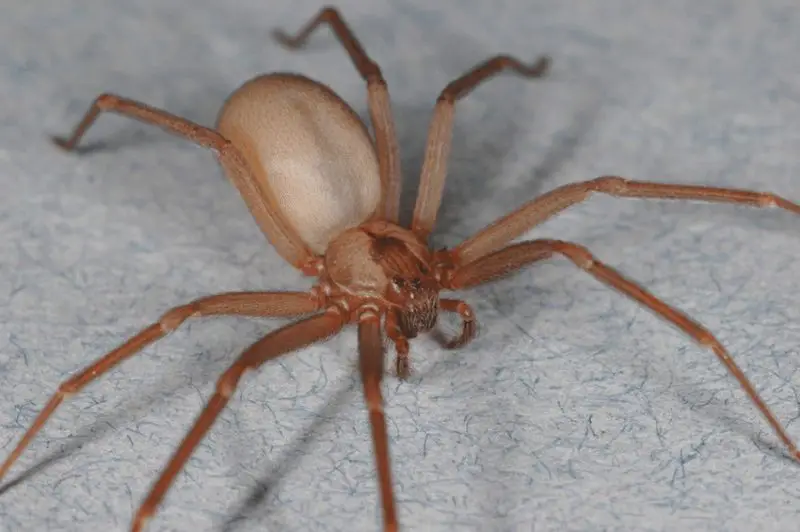
The Brown Recluse Spider (Loxosceles reclusa) is one of the most feared spiders in North America, known for its potentially harmful bite, though it is extremely rare in Vermont. This spider is small to medium-sized, measuring about 6 to 20 millimeters in body length, with light to dark brown coloration and a distinctive dark violin-shaped marking on its cephalothorax. Its six eyes—arranged in three pairs—set it apart from most spiders, which have eight.
Brown Recluse Spiders are nocturnal hunters that prefer dark, dry, and undisturbed areas such as basements, attics, or woodpiles. They feed on small insects and typically avoid human contact, biting only when trapped against the skin. Their webs are irregular and used primarily as retreats rather than traps for prey. Despite their reputation, bites are relatively uncommon, even in regions where they are established.
The venom of a Brown Recluse contains necrotic toxins that can destroy skin and underlying tissue. Bites often start as painless red lesions that develop into blisters and ulcers over several days. Severe cases may lead to tissue necrosis requiring medical attention, though such outcomes are rare. Most bites heal without complication, but secondary infections can occur if the wound is not properly cleaned.
In Vermont, Brown Recluse sightings are extremely uncommon and usually linked to imported goods or travelers from the southern U.S. The species is not considered native or established in the region. Residents occasionally mistake harmless house spiders for recluses. Preventing clutter, sealing entry points, and shaking out stored clothing or bedding can help avoid accidental contact with these elusive spiders.
Black Widow Spider
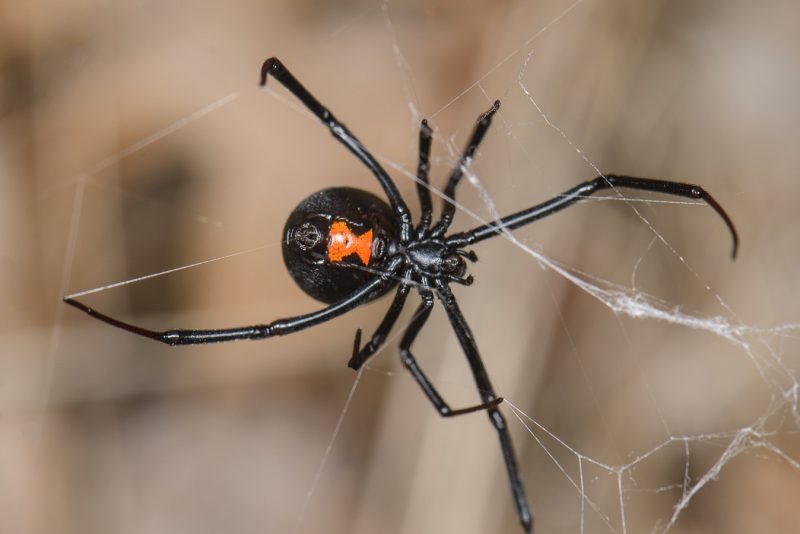
The Black Widow Spider (Latrodectus mactans) is a distinctive arachnid rarely found in Vermont, identifiable by its glossy black body and the bright red hourglass marking on the underside of its abdomen. Females, which are about 10 to 13 millimeters long, are larger and more venomous than males, whose coloration is lighter and markings less vivid. Their long, slender legs and shiny appearance make them stand out among native spider species.
Black Widows prefer secluded, sheltered environments such as woodpiles, sheds, stone walls, and crawl spaces. They spin irregular, messy webs close to the ground, using them both as traps and as protection for their egg sacs. Although they are shy and non-aggressive, females will bite if provoked or disturbed, particularly while guarding their eggs. Their diet consists primarily of insects, which they immobilize with venom before feeding.
The venom of the Black Widow contains a potent neurotoxin called latrotoxin, which affects the nervous system. Symptoms of a bite include sharp pain, muscle cramps, sweating, and nausea, typically appearing within an hour. While bites are rarely fatal, they can cause severe discomfort and require medical attention, especially for children, the elderly, or those with health conditions. Antivenom and supportive care are effective treatments in serious cases.
In Vermont, confirmed sightings of Black Widows are rare and typically involve transient individuals carried by shipments of goods from warmer states. The species is not native to the region but may occasionally survive brief periods in sheltered indoor areas. Caution is advised when handling firewood or debris where spiders may hide, though encounters in Vermont remain exceptionally uncommon.
Assassin Bug (Kissing Bug)
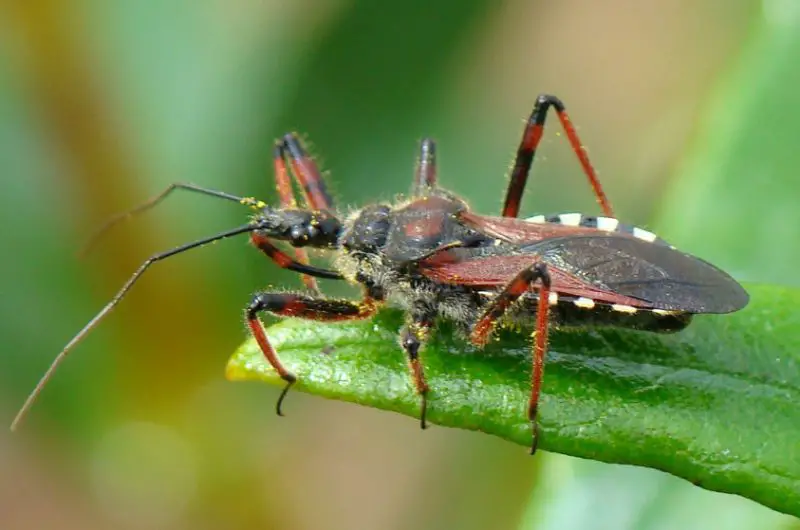
The Assassin Bug, particularly the Kissing Bug (Triatoma sanguisuga), is a predatory insect known for its piercing-sucking mouthparts and stealthy behavior. Adults measure between 15 and 25 millimeters long, with elongated dark bodies, narrow heads, and reddish-orange markings along their abdomen edges. Although they feed primarily on other insects, certain species, including the Kissing Bug, are known for biting humans around the mouth or eyes during the night.
These nocturnal insects hide during the day in cracks, animal nests, or under debris, emerging at night to feed. Most Assassin Bugs are beneficial predators, preying on pests like caterpillars, aphids, and beetles. However, the Kissing Bug is of medical concern due to its potential to carry Trypanosoma cruzi, the parasite that causes Chagas disease—a tropical illness rarely seen in the U.S.
Bites from Kissing Bugs can cause allergic reactions, swelling, and irritation. The danger arises when the insect defecates near the bite, and the parasite enters the body through mucous membranes or broken skin. Though cases of Chagas disease in Vermont are virtually nonexistent, the possibility of transmission underscores the need for awareness, particularly in warmer climates where these insects are more common.
In Vermont, Assassin Bugs are occasionally observed during the summer months but are mostly harmless native species that prey on other insects. The Kissing Bug, in contrast, is extremely rare and not considered established in the region. Residents who suspect finding one should collect the specimen carefully and contact local health departments or entomologists for identification and guidance.
Blister Beetle
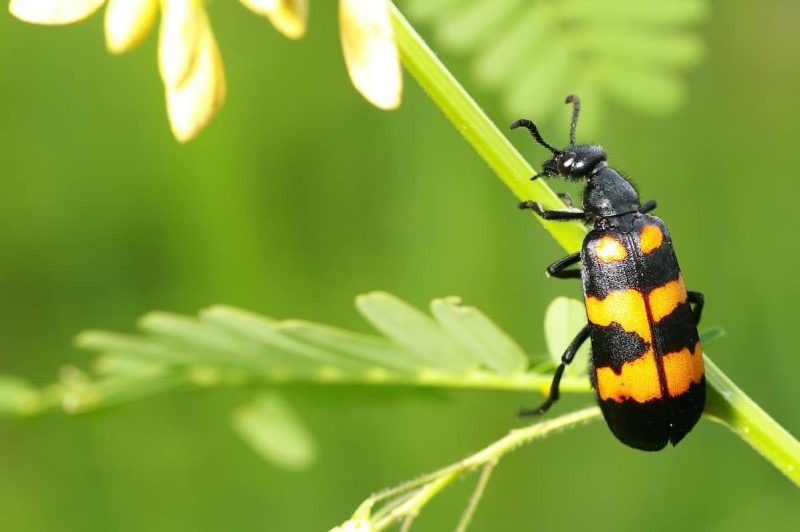
Blister Beetles (family Meloidae) are slender, soft-bodied insects known for their defensive chemical secretion, cantharidin—a potent toxin that causes skin irritation and blistering upon contact. Adults range from 10 to 25 millimeters long and come in various colors, including black, gray, or striped orange and black. Their narrow necks and flexible wing covers give them a distinct appearance compared to other beetles.
These beetles are often seen on flowering plants such as alfalfa, goldenrod, and milkweed, feeding on nectar, pollen, or foliage. While adults can damage crops, their larvae are beneficial predators that feed on grasshopper eggs. Despite their agricultural importance, their toxic nature poses risks to both humans and livestock, particularly horses, which can suffer poisoning from ingesting contaminated hay.
When threatened or crushed, Blister Beetles release cantharidin, a defensive compound that causes painful blisters and inflammation on human skin. Contact with mucous membranes or open wounds can intensify the reaction, and ingestion is highly toxic. Although they do not bite or sting, careless handling or accidental contact can result in serious irritation or burns.
In Vermont, Blister Beetles appear during mid to late summer, especially in agricultural areas and wildflower meadows. Their presence varies by year depending on weather conditions and crop abundance. Avoiding direct handling and wearing gloves when gardening or cutting hay can prevent exposure. While not typically aggressive, their chemical defense makes them one of the more deceptive and dangerous beetles in the region.
Centipede (House Centipede)
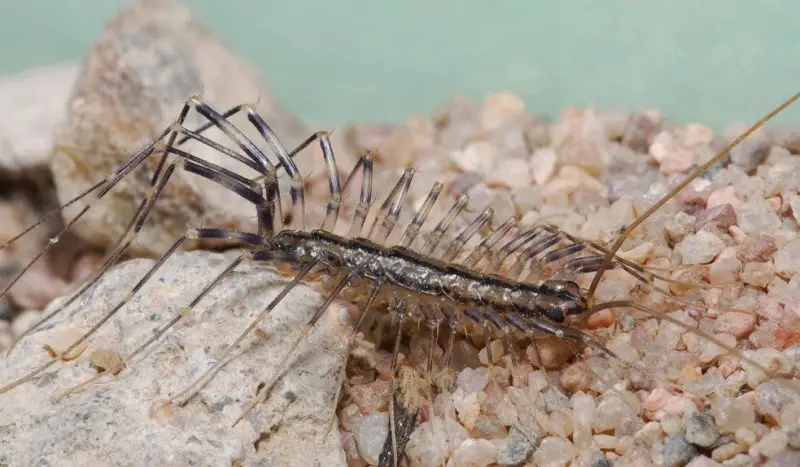
The House Centipede (Scutigera coleoptrata) is a fast-moving arthropod commonly encountered in Vermont homes, basements, and damp environments. It has a long, flattened body that can reach up to 3 centimeters in length, with 15 pairs of long, delicate legs giving it a distinctive, almost feathery appearance. Its coloration is typically yellowish-gray with darker stripes running along the body, which enhances its speed and camouflage.
House Centipedes are nocturnal hunters that feed on small household pests, including cockroaches, spiders, and termites. They use their venomous front legs (forcipules) to immobilize prey, making them beneficial for pest control. Despite their alarming appearance and rapid movement, they rarely pose a danger to humans. They prefer cool, damp areas such as bathrooms, basements, and under sinks, where humidity levels are high.
Though centipedes are not aggressive, they may bite if handled or trapped against the skin. Their bites can cause localized pain, redness, and swelling similar to a bee sting, but serious reactions are extremely uncommon. The discomfort typically subsides within a few hours or a day. Only individuals with strong allergic sensitivities might experience prolonged irritation or mild systemic symptoms.
In Vermont, House Centipedes are active year-round indoors but are more noticeable during warm and humid seasons. They thrive in dark corners and hidden spaces, often emerging at night. Maintaining dry environments through dehumidifiers and sealing cracks in walls can deter infestations. Despite their unsettling look, these creatures are considered helpful natural pest managers rather than harmful invaders.
Giant Water Bug
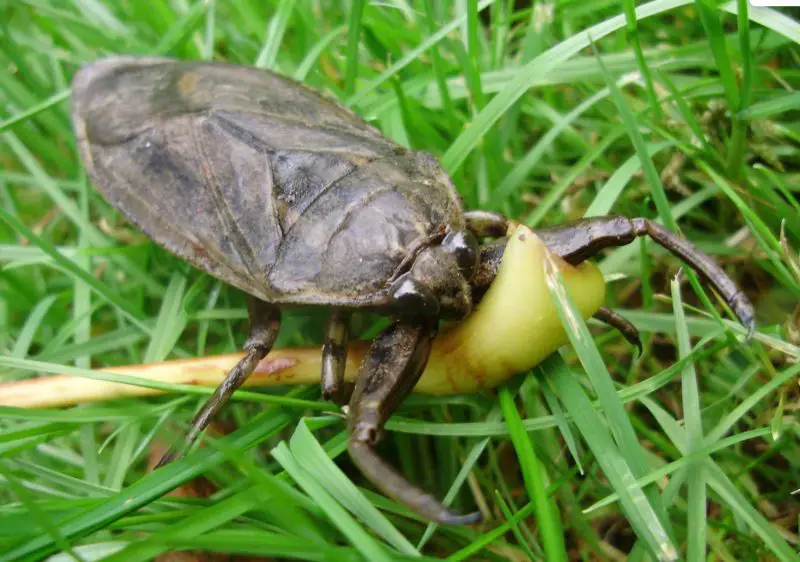
The Giant Water Bug (Lethocerus americanus) is one of the largest aquatic insects in Vermont, often reaching lengths of 4 to 6 centimeters. It has a flat, oval body that is brownish in color, aiding its camouflage among aquatic vegetation and muddy pond bottoms. Equipped with powerful front legs designed for grabbing prey, these insects are formidable underwater hunters. Their size and silent movements have earned them the nickname “toe-biters.”
These predatory insects inhabit freshwater environments such as ponds, lakes, and slow-moving streams. They feed on fish, amphibians, and even small aquatic invertebrates by injecting digestive saliva that liquefies the prey’s tissues, which they then suck up. Despite their aquatic nature, they can fly and are often attracted to lights at night, occasionally landing on porches or near water sources during summer months.
The bite of a Giant Water Bug is extremely painful due to its piercing-sucking mouthparts and potent saliva. While the venom is not dangerous to humans, it causes intense burning, swelling, and numbness at the site, sometimes lasting several hours. They generally bite only in self-defense, often when accidentally stepped on in shallow water or handled carelessly.
In Vermont, Giant Water Bugs are found throughout freshwater habitats during the warmer months, typically between May and September. They overwinter in mud or underwater debris. Swimmers should exercise caution when wading barefoot in ponds or lakes where these insects live. Despite their painful bite, they play an important ecological role by controlling populations of aquatic pests and small vertebrates.
Flea (Cat and Dog Fleas)
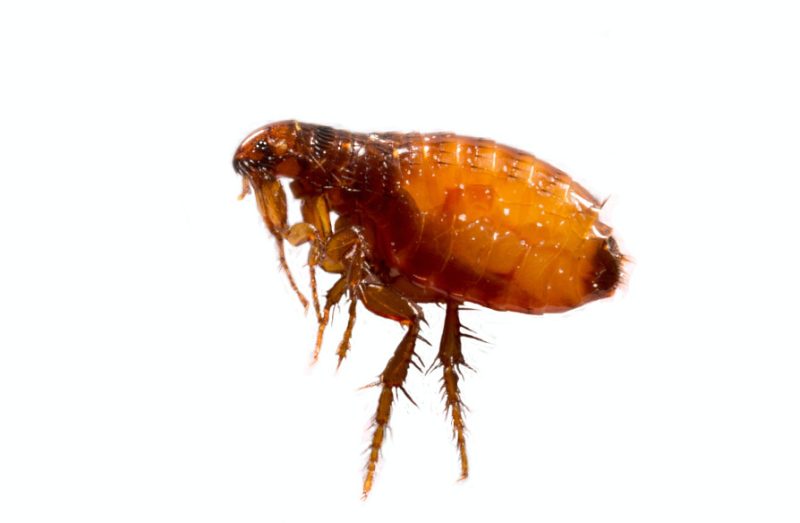
Cat Fleas (Ctenocephalides felis) and Dog Fleas (Ctenocephalides canis) are common blood-feeding parasites that infest both pets and wildlife in Vermont. These tiny, wingless insects measure about 2–3 millimeters long and have flattened, reddish-brown bodies covered in tough exoskeletons. Their long hind legs enable impressive jumps, allowing them to move easily between hosts or onto humans.
Fleas feed on the blood of mammals and birds, causing irritation and discomfort with their bites. They thrive in warm, humid environments such as pet bedding, carpets, and shaded outdoor areas. Adult fleas spend most of their time on a host, while eggs, larvae, and pupae develop in the environment, making infestations persistent and difficult to eliminate without thorough cleaning and treatment.
Beyond causing itchy, red bites, fleas can transmit several diseases and parasites. They are known vectors of tapeworms (Dipylidium caninum) and can spread bacterial infections like murine typhus. Their bites often result in allergic dermatitis in sensitive pets and humans, leading to scratching, hair loss, or skin infections. In severe infestations, young animals can even suffer anemia from blood loss.
In Vermont, fleas are active primarily during the warmer months but can survive indoors year-round. Regular pet grooming, the use of flea preventatives, and frequent cleaning of carpets and pet bedding are essential for control. Outdoor areas frequented by animals should also be treated to break the flea life cycle and prevent reinfestation.
Bed Bug
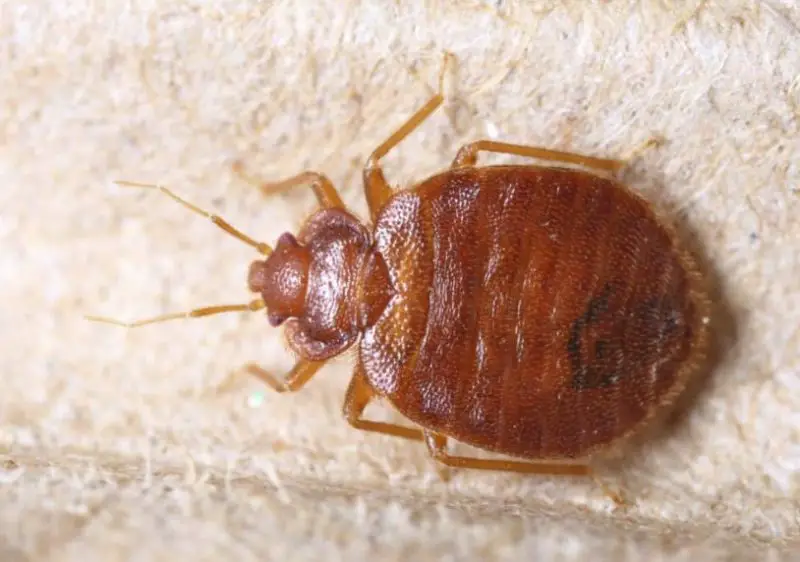
The Bed Bug (Cimex lectularius) is a small, reddish-brown, wingless insect that feeds exclusively on human blood. Adult bed bugs measure about 4–5 millimeters in length, with flat, oval bodies that become swollen and darker after feeding. Their stealthy behavior and nocturnal feeding habits make them difficult to detect until infestations become established, as they often hide in mattresses, furniture seams, and crevices during the day.
Bed Bugs are not known to transmit diseases, but their bites can cause itchy welts, allergic reactions, and significant psychological distress. They typically bite exposed skin while humans sleep, often in a linear or clustered pattern. Their feeding is painless, as they inject anesthetic and anticoagulant saliva to facilitate blood flow, though itching and inflammation appear afterward.
Infestations can spread rapidly because of their ability to hide in tiny cracks and their resistance to many common pesticides. They can hitchhike in luggage, furniture, or clothing, making them common in hotels, dormitories, and apartment buildings. Heavy infestations may produce a musty odor and dark fecal spots on bedding or walls.
In Vermont, bed bug infestations have been reported in both urban and rural settings, particularly in densely populated housing areas. Regular inspection of sleeping areas, vacuuming, and heat treatment are effective control measures. Professional pest control is often required to eliminate large infestations completely. Maintaining cleanliness and vigilance during travel are key to prevention.
Louse (Body or Head Lice)
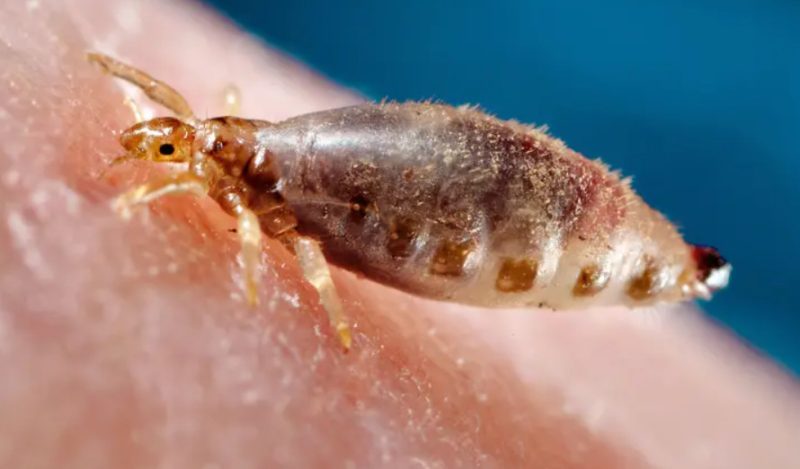
Lice are tiny, wingless parasitic insects that live on humans, feeding on blood and clinging to hair or clothing with specialized claws. Head Lice (Pediculus humanus capitis) infest the scalp, while Body Lice (Pediculus humanus humanus) live on clothing and move to the skin to feed. They are typically 2–4 millimeters long, grayish-white in color, and barely visible without close inspection.
Head Lice are most common in school-aged children, spreading through direct contact or shared personal items like hats and brushes. Body Lice, on the other hand, are associated with poor hygiene or crowded living conditions. Both types cause intense itching due to allergic reactions to their saliva. Repeated scratching can lead to sores, secondary infections, and sleep disturbances.
Although lice do not transmit major diseases in Vermont, Body Lice elsewhere have been known to spread typhus and trench fever. Their eggs (nits) cling tightly to hair shafts or fabric fibers, making removal difficult without specialized combs or treatments. Over-the-counter or prescription pediculicides are often needed for effective eradication.
In Vermont, lice infestations occur year-round, especially in communal environments such as schools or shelters. Regular head checks, good hygiene, and avoiding shared hair accessories are essential preventive measures. Prompt treatment and thorough cleaning of bedding and clothing help break the infestation cycle and reduce reoccurrence.
Velvet Ant (Cow Killer Ant)
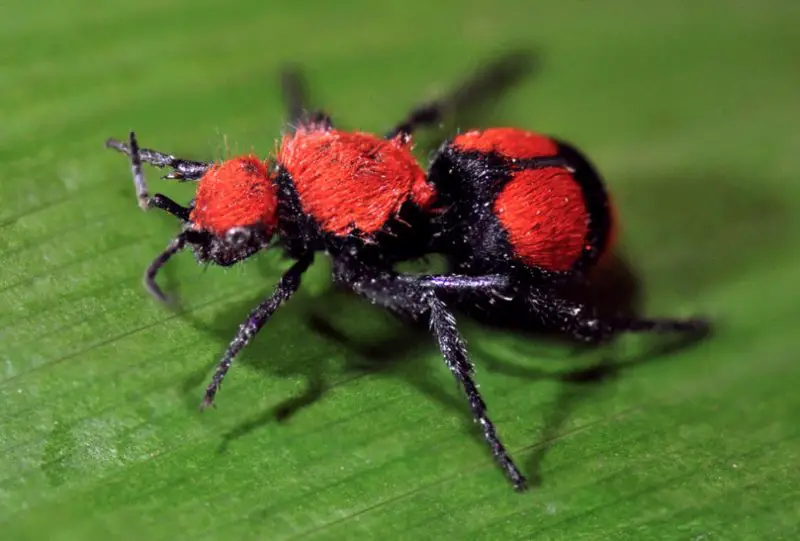
The Velvet Ant (Dasymutilla occidentalis), often called the “Cow Killer Ant,” is actually a type of wingless wasp known for its vivid coloration and intensely painful sting. Females are covered in dense red-orange and black hairs and can reach up to 20 millimeters in length, while males are winged and less commonly seen. Their bright coloration serves as a warning to predators of their potent venom and defensive nature.
These solitary wasps are usually found in dry, sandy areas, meadows, and open woodlands where they search for ground-nesting bees or wasps. Female Velvet Ants lay eggs in the nests of these insects, where their larvae consume the host’s developing brood. Despite their common name, they do not form colonies or seek human interaction, but they move quickly and are difficult to catch.
The sting of a Velvet Ant is infamous for its intensity—reportedly one of the most painful of any insect in North America. It delivers venom that causes immediate burning, swelling, and redness lasting for several hours. While not lethal and unlikely to kill livestock, the pain is excruciating and can leave lingering soreness or numbness at the sting site. The species does not bite and will only sting in self-defense.
In Vermont, Velvet Ants are rare but occasionally encountered during midsummer in sandy fields or near pollinator nesting sites. Their striking appearance and solitary habits make them easily recognizable. Observing them from a distance is recommended, as they are best admired for their unique biology rather than handled. Despite their fearsome reputation, they play a role in regulating other insect populations within the ecosystem.
Tips for Avoiding Dangerous Bugs in Vermont
Be Cautious in Tick-Prone Areas
When exploring Vermont’s forests, meadows, or trails, wear long sleeves, tuck pants into socks, and use insect repellent containing DEET or permethrin. Perform a thorough tick check after outdoor activities—especially behind the knees, under arms, and along the hairline. Early tick removal reduces the risk of Lyme disease and other infections.
Avoid Disturbing Wasp and Hornet Nests
Yellowjackets, Bald-faced Hornets, and Paper Wasps are most aggressive when defending their nests. Avoid approaching or disturbing any visible paper-like nests around trees, sheds, or eaves. If you find one near your home, contact pest control professionals for safe removal rather than attempting it yourself.
Protect Pets and Livestock
Fleas, mosquitoes, and flies can affect pets and farm animals by spreading parasites and causing skin irritation. Use veterinarian-approved flea treatments, regularly clean pet bedding, and keep animal enclosures dry. Eliminating standing water will also reduce mosquito breeding sites around barns or gardens.
Handle Outdoor Activities Wisely
Wear closed shoes when wading in lakes or streams to avoid Giant Water Bugs and other aquatic biters. Avoid wearing floral perfumes or bright clothing that can attract bees and wasps. Carry antihistamines or an epinephrine auto-injector if you have known allergies to insect stings.
Keep Indoor Areas Clean and Dry
Centipedes, bed bugs, and lice thrive in cluttered or humid environments. Use dehumidifiers, vacuum regularly, and seal cracks in walls to minimize hiding spots. Launder bedding and clothing frequently at high temperatures to eliminate pests and prevent infestations from spreading indoors.
FAQs about Dangerous Bugs in Vermont
What is the most dangerous insect in Vermont?
The Deer Tick (Black-legged Tick) is considered the most dangerous because it transmits Lyme disease, anaplasmosis, and babesiosis. While its bite is painless, the long-term effects of these illnesses can be severe if not treated promptly.
Can Vermont’s wasps and hornets kill a person?
Fatal stings are extremely rare but possible for individuals with severe allergies to wasp venom. Species like the Bald-faced Hornet and Yellowjacket can sting multiple times, and allergic reactions may cause anaphylaxis. Immediate medical care is essential after severe swelling or difficulty breathing.
Are spiders in Vermont dangerous?
Most Vermont spiders are harmless. The Brown Recluse and Black Widow are rarely found in the state, and verified bites are exceptionally uncommon. If bitten by an unidentified spider and the area becomes necrotic or painful, seek medical evaluation.
Do mosquitoes in Vermont carry diseases?
Yes, though cases are infrequent. Mosquitoes in Vermont can transmit West Nile virus and Eastern equine encephalitis (EEE). These diseases occasionally appear during warm, wet summers when mosquito populations are high.
What should I do if I’m bitten by a Giant Water Bug or Deer Fly?
Clean the area thoroughly with soap and water, apply ice to reduce swelling, and use antiseptic or antihistamine cream for pain relief. Seek medical attention if severe allergic reactions or signs of infection (such as pus, fever, or persistent redness) appear.
How painful is the Velvet Ant sting?
The Velvet Ant’s sting is among the most painful of any North American insect. It causes intense burning and swelling that can last for several hours, though it is not lethal. Avoid handling these insects—they sting only in self-defense.
Can bed bugs or lice spread diseases?
Bed bugs do not transmit diseases but cause itchy bites and allergic skin reactions. Lice, particularly body lice, can spread bacterial infections in unsanitary conditions, though this is uncommon in Vermont. Proper hygiene and cleaning can prevent infestations.
When are biting insects most active in Vermont?
Biting insects like mosquitoes, flies, and ticks are most active during late spring through early fall, particularly after rain or in humid weather. Nighttime and dusk are peak feeding times for mosquitoes, while ticks are active anytime temperatures are above freezing.
How can I protect my pets from fleas and ticks?
Use monthly flea and tick prevention treatments prescribed by veterinarians. Regularly check your pets’ fur, especially after walks in grassy or wooded areas. Wash pet bedding in hot water and vacuum carpets frequently to eliminate flea eggs and larvae.
Should I report sightings of dangerous or invasive insects?
Yes. Rare or invasive species such as Fire Ants or Kissing Bugs should be reported to the Vermont Agency of Agriculture or local extension services. Early detection helps prevent establishment and protects local ecosystems from invasive threats.


